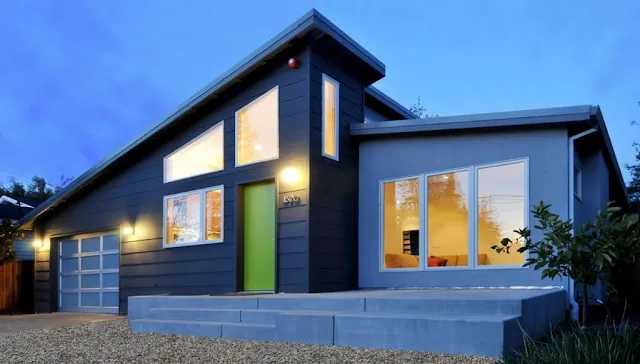Contemporary style house designs are known for their simple, yet elegant exteriors. These homes typically forgo elaborate ornamentation, instead featuring large and varied glass inserts, often combined with materials like brick, stonework, or mixed metals. What truly sets contemporary exteriors apart are their distinctive flat or sloped rooflines. These, coupled with expansive windows, create interiors that feel open, airy, and grand.
What Defines Contemporary Style?
Contemporary design (often confused with "modern") embraces current trends while prioritizing function, light, and connection to nature. Think:
- Fluid, open layouts that erase barriers between kitchen, living, and dining areas.
- Bold geometric forms—asymmetrical rooflines, cantilevered volumes, and curved walls.
- Expansive glazing (floor-to-ceiling windows, sliding glass walls) blurring indoor/outdoor lines.
- Natural, sustainable materials like reclaimed wood, polished concrete, and recycled steel.
- Neutral foundations (whites, grays, beiges) punctuated by strategic color accents in art, furniture, or architectural elements.
As noted by Architectural Digest, contemporary homes prioritize "light, space, and a sense of calm" while reflecting technological and material innovations of the 21st century .
One of the criteria that make these house designs special and different from the other is location of the house. Which can actually make an important role in the way house is designed. Because nature always have big impact on these house design type.
Key Inspirations for Your Contemporary Home
1. The Art of the Facade: Dynamic Exteriors
Gone are the boxy silhouettes. Today’s contemporary homes play with texture, scale, and contrast:
- Material Mixology: Combine warm wood cladding with cool metal panels or raw concrete.
- Asymmetry: Angled roofs or offset volumes create visual intrigue without clutter.
- Greenery Integration: Living walls or rooftop gardens soften hard lines.
House exterior design ideas with contemporary style. This creative and imaginative approach to home building is highlighted with new home ideas. It's so well blend with timeless design and a beautiful pattern.
Exterior highlights may include a series of boxy spaces. Some type of mixed siding that is usually sleek featuring clean lines. Contemporary wood exteriors that can also be a stylish exterior choice.
2. Interior Flow: Light, Space, and Air
Open plans reign supreme, but zoning is key:
- Floor-to-Ceiling Windows: Maximize natural light and frame views (e.g., forests, cityscapes).
- Flexible Zones: Use furniture, rugs, or split levels to define areas in an open layout.
- Minimalist Fireplaces: A sleek linear fireplace becomes a sculptural focal point.
3. Materials That Tell a Story
Sustainability is non-negotiable in contemporary design:
- Reclaimed Wood: Adds warmth to walls, ceilings, or statement beams.
- Polished Concrete Floors: Durable, low-maintenance, and ideal for radiant heating.
- Recycled Metal: Steel supports or corrugated accents add industrial chic.
According to the National Association of Home Builders, 84% of buyers now prioritize eco-friendly materials—contemporary design leads this shift.
But for better weather resistant and strong materials, aluminum or steel external wall element features can also appeal to those looking for an industrial or retro finish.
4. Color & Texture: Less Is More (Until It’s Not!)
Why neutral Backdrop walls and floors in whites, taupes, or soft grays create serenity? Neutrals provide a harmonious backdrop that allows furniture, textures, and accents to shine without overwhelming the space. This contributes to an uncluttered, relaxing environment.
Strategic pops such as vibrant art, a mustard-yellow sofa, or terracotta pots energize spaces. They're excellent for exteriors if you're aiming for a space that feels inviting, creative, and full of life. These elements energize without overwhelming, especially when grounded with natural textures (like wood, jute, or stone). The key is to strike a balance: let vibrant pieces stand out while keeping the background neutral or organic to avoid visual clutter.
Tactile Layers: A chunky knit throw, woven rug, or bouclé chair adds depth without visual noise. A chunky throw, a woven rug, or a bouclé chair doesn't shout; it whispers. These tactile elements add emotional and visual warmth, making a room feel full and thoughtful—without visual clutter or chaos. They're the secret sauce behind a room that feels rich yet restful.
5. Tech-Savvy & Sustainable Systems
Contemporary homes marry aesthetics with intelligence:
- Smart Home Integration: Hidden speakers, automated shading, and energy monitoring.
- Passive Design: Deep overhangs for shade, cross-ventilation windows, and solar panels.
- Water Conservation: Rainwater harvesting systems and drought-tolerant landscaping.
Why Contemporary Design Endures
This style thrives because it’s adaptable. Whether you’re in a city loft or a mountain retreat, it prioritizes well-being, sustainability, and authenticity. As we spend more time at home, spaces that feel open, light-filled, and intentional aren’t just stylish—they’re essential.
Ready to reimagine your space? Start with one contemporary element—a bold light fixture, a monochrome palette, or a window seat framing your garden. Small steps can redefine how your home feels.
Many people believe that a house needs to be large or expensive to be considered amazing or beautiful. However, that's not always the case. As you'll see in this list, some truly stunning modern house designs are quite small. Ultimately, good architecture, combined with thoughtful color choices and cohesive style, can create a gorgeous modern home, regardless of its size.











